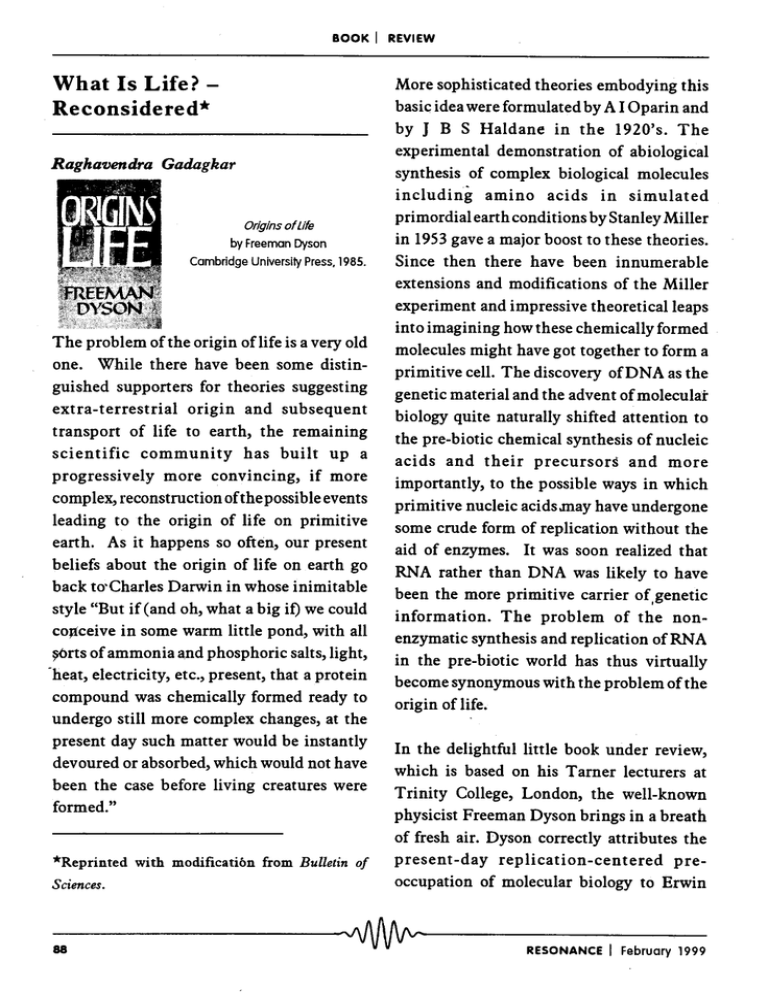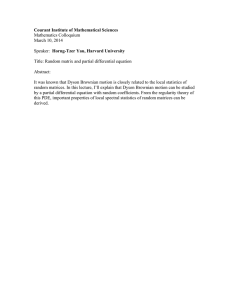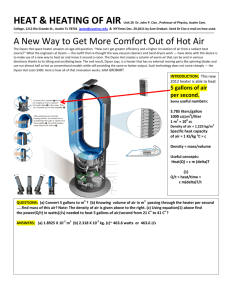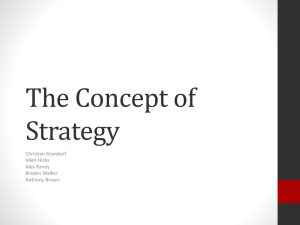BOOK I REVIEW
advertisement

BOOK I What Is Life? REVIEW -More sophisticated Reconsidered* basic idea by J theories were B S Gadagkar of complex including in F Cambridge University Press, 1985. earth 1953 g ave Since there into one. While guished of the origin there have been for theories origin and supporters extra-terrestrial transport of scientific life leading to more convincing, the As it beliefs about to. Charles style "But in Darwin oh, some warm whose little present, present day devoured the chemically more such we that matter be which would not case living creatures to origin from Bulletin In ways replication was was that likely to of has the nonofRNA thus the have of,genetic replication with the realized problem and which undergone carrier world more without soon primitive The nucleic in have It synonymous virtually problem of the of life.. the have which were Trinity of .occupation Sc~ences. 88 of to the of modification of molecular attention possible may a as the and of pre-biotic physicist with advent DNA form ofDNA synthesis synthesis the become formed." *Reprinted more enzymatic in instantly or absorbed, before all at the formed to shifted acids than information. light, ready changes, would could the form rather been a protein formed complex to Miller leaps together precursors enzymes. RNA the chemical crude the chemically discovery their nucleic of innumerable theoretical naturally and . theorIes. of got and pre-biotic acids aid go with salts, quite some earth if) biology primitive present pond, etc., was events inimitable a big material importantly, primitive on electricity, still on life phosphoric more possible of and compound if a The Miller these been these have cell. genetic the up how might primitive remaining built our what distin- simulated Stanley to impressive imagining molecules subsequent life in old suggesting often, of ammonia undergo been of so origin if(and coJlceive -heat, origin the back some of the happens is a very the has reconstruction earth. ~rts earth, community progressively complex, to of life abiological in modifications and The molecules by have and experiment problem acids boost and 1920's. of conditions a major then extensions The the biological amino primordial y reeman Dy son b in this A IOparin demonstration synthesis Originsof life by Haldane experimental. Raghavendra embodying formulated fresh delightful. is based on College, Freeman air. Dyson present-day his book under Tarner London, the Dyson brings correctly review, lecturers molecular at well-known in a breath attributes replication-centered of -"\N\j\",~ little biology the pre- to Erwin RESONANCE I February1999 BOOK I REVIEW Schrodinger's advice to biologists to inves- willing to call it a theory), metabolism or ligate the molecular structure of the gene. proteins evolved first, and once this crude But then why did Schrodinger call his book hardware was available, nucleic acid or the What is life? Because, says Dyson, Schro- software evolved in a second step. In today's dinger equated life with 'replication' and neglected to worry about 'metabolism' (perhaps wisely at that time, asMukunda has organisJDsnucleic acidsareneededfor protein synthesis and proteins are needed for nucleic acid synthesis. So which came first, the argued in the accompanying review of chicken or the egg?Dyson clearly prefers the Schrodinger's book). But Dyson argues convincingly that the time has now come to chicken (= metabolism or protein) for step one and argues that a primitive form of life once again ask "What is life?" and focus this time around on 'metabolism' rather than consisting only of protein must have arisen first, growing, metabolising and reproducing replication. in some crude fashion before nucleic acids came along in steptwooApart from its logical ongtns . ifL :£ 0 full 0 %Je IS f 0 I h 0 virtues. t as new 1 0 1 d d l obi 1 eas,prOVI es a p ausl e so utlon to a ongo o d o stan mg bl d pro em h an even h as a mat what e- 0 1 d 1 h 1 1 matlca mo e w ose resu ts are not on y ~ b 1 11 0 . hk arge y consistent Wit nown lacts ut a so suggest D new ' k yson s stye d h rea; e never 0 cautions ma t b e overstates d e rea h er on t k 1 o b e d oun d h h 0 I dd o 0 ~ lact an ypot esls. n a Itlon b ary a master t oo m settIng h o 0 0 77 IS m Just pages fi ~ or. The accumulated wisdom of the variations of the Stanley Miller has readily D h o h IS ypot yson h d oes 0 0 eSlS m k at more conditions but nucleotides, h -w embarrassment been that in simulated amino acids are pre-biotic nucleic are much acid harder bases, let to come alone by. If etween 1 0 y JO a ho 1 0 All ho 0 1 d h ol Istonca an p 1 osop lca perspective. b an acute 0 to expenmentallsts. formed a p easure to d 1 IS case an a ways been 00 h h t h es has long 0 0 .experiment to expenmental1sts. approaches 1 reasonableness,this sequencemakes senseof can one as only proteins 0 0 pre-bl0tlcally 0 0 0 proteins, the needed to have been produced 0 0 .0 and o. mslde pnmltlve nucleic " acids orlgmated 0 0 cells already contammg experimental findings make perfect sense. Dyson's main thesis is that life originated twice, not just once. First he makes a very convincing case for the distinction between what he calls replication (= nucleic acid) and metabolism (= protein). Borrowing on von Neumann's analogy, he equatesnucleic acid Buthowdidtheprimitive'protein'organism get along without nucleic acids? Dyson recognises that they must have been beyond the reach of Darwinian natural selection becausethey could not have reproduced with any level of precision. He therefore uses to softwareand protein to hardwareand reminds us that hardware logically comes before Kimura's neutral theory of evolution to deal with these primordial 'cells'. But it is Dyson's software. So in Dyson's hypothesis (he is not treatment of the subsequentevolution ofRNA RESONANCE I February 1999 -JV\Mf\I-- 89 ~~~ BOOK I REVIEW as a parasite that is most appealing in the can possibly catalyze their own replication context of present-day evolutionary biology. IfRNA (or DNA) is the software it can exist as a parasite on the hardware without have led somebiochemists to believe that the chicken and egg problem has finally been solved in favourofRNA but I would hazard a contributing anything in return. That is precisely what most present-day viruses do. guessthat such a conclusion is too premature -the logic in Dyson's arguments (in favour of The primitive RNA must have started off as a parasite until the protein-based life "learned protein) is so compelling that we need to tread here with caution. At the very least, to make use of the capacity more biochemists should read Dyson for exact replication which the chemical structure of RNA provided" and "The primal symbiosis b dI d ' , RNA f 0 protelll- ase lie an parasltic grew . gradually ' +" into a harmonious unity, the modern genetic apparatus". Recent findings that RNA molecules can sometimes have enzymatic properties and ~ "I ' ' Bangalore 560012, India, and Evolutionary andOrganismal BiologyUnit,Jawaharlal NehmCentreforAdvancedScientific Research, Jakkur, Bangalore 560064,India, Email: ragh@ces,iisc,emetin The way to solve the conflict between human values and technological needs is not to run away from technology. That's ~ J' RaghavendraGadagkar,Centre for Ecological SClences, ' I ndIan I nstltute ' 0f Science, II impossible. The way to resolve the conflict is to break down the barriers of dualistic thought that prevent a real understanding of what technology is -not an exploitation of nature, but a fusion of nature and the human spirit into a new kind of creation that transcends both. When this transcendence occurs in such events as the first airplane flight across the ocean orthe first footstep on the moon, a kind of public recognition of the transcendent nature of technology occurs. But this transcendence should also occur at the individual level, on a personal basis, in one's own life, in a less dramatic way. Robert M Pirsig 90 -JVV'J\fv- RESONANCE I February '. 1999




